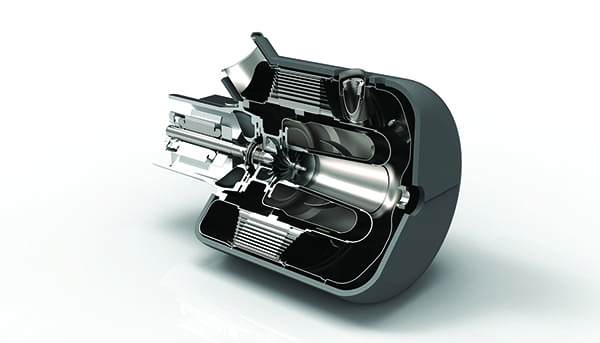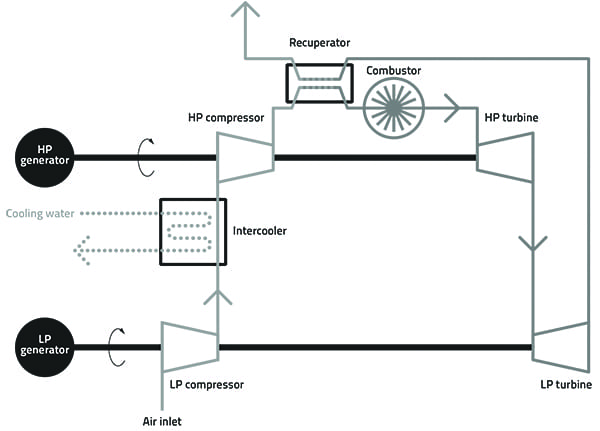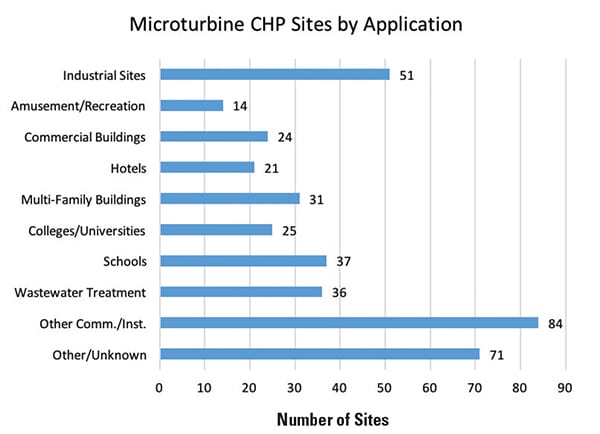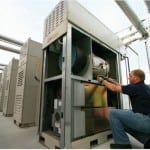Gas turbines come in a variety of sizes. While large combustion turbines seem to get the bulk of the publicity, with the likes of Siemens, GE, and Mitsubishi Hitachi Power Systems making the most noise, several smaller companies have discovered niches in the microturbine market. Their innovative designs are specifically finding interest in the commercial and industrial segments.
When many people think of microturbines, they often envision small units producing as little as 30 kW of power. While such units are novel, the industry has evolved greatly over the past decade and multipack units can reach up to 30 MW in total capacity these days.
The consulting firm ICF Inc. maintains a combined heat and power (CHP) installation database for the U.S. Department of Energy. It is considered the most-comprehensive source of information on CHP installations in the country. ICF recently reported that microturbines captured a 25% market share of U.S. CHP installations in the 100 kW to 5 MW range during the 2013–2017 period. That set a new record.
According to the database, the total installed capacity of CHP systems less than 5 MW was 2,631.4 MW at the end of 2017. ICF forecasts that U.S. CHP annual capacity installations will grow from 561 MW in 2017 to as much as 1,400 MW in 2026. The growth is expected to be driven by smaller commercial applications that are typically compatible with microturbine technology.
“Considering record low gas prices and its stability for the foreseeable future, development of cogeneration projects present an attractive opportunity with multiple revenue streams—steam sold to hosts for industrial processes and electric power sold to the grid,” Siraj Taj, principal and owner of ST Power Services Consultants, told POWER. “Commercial and industrial consumers are assessing economic viability of behind-the-fence cogeneration to reduce operating costs, improve reliability, achieve energy efficiency goals, and reduce their carbon footprint,” he added.
Powering Industrial Processes
Almost a decade ago, POWER was reporting on the growth in microturbine systems (see “Microturbine Technology Matures” in the November 2010 issue). Capstone Turbine Corp., which claims to be the world’s leading developer and manufacturer of microturbine power generation systems, was peddling single units with capacities of up to 1 MW even back then. Today, all of Capstone’s units can be paralleled up to 30 MW in capacity.
To understand where these packages can be beneficial, consider Felsineo La Mortadella. The company is an Italian food processor that produces a finely ground, heat-cured pork sausage. It was featured in a case study published on Capstone’s website.
Felsineo was looking to upgrade the power generation system at its primary manufacturing facility in Bologna. It wanted one that could handle an increase in the production of saturated steam for sausage making.
The company decided to install Capstone’s natural gas-fueled C1000 microturbine (Figure 1) along with a gas compressor and post-combustion steam generator solution. The Felsineo project was Capstone’s first microturbine to utilize a post-combustion steam solution, which successfully satisfied both the electrical and thermal demands of the facility. The overall efficiency of the manufacturing plant improved 30%, saving Felsineo about €300,000 per year, according to the case study.
 |
|
1. Capstone Turbine Corp. offers a line of microturbines from its 30-kW C30 design (cutaway shown here) to its 1-MW C1000S unit. Courtesy: Capstone Turbine Corp. |
“Capstone’s new Signature Series product line-up is making significant progress in the CHP market, which is specifically focused on growing the energy efficiency market vertical and continuing to diversify Capstone’s business,” Jim Crouse, Capstone’s executive vice president of Sales and Marketing, said in a recent press release about growth in the CHP market.
World’s Most Efficient Small Gas Turbine
Aurelia Turbines is a relative newcomer to the market—the company was established in 2013—but its technology has been under development for decades. The company’s main office and manufacturing facilities are located in Lappeenranta, Finland. The location is significant because Aurelia worked in collaboration with the Lappeenranta University of Technology to develop its new gas turbine.
According to Aurelia’s CEO Matti Malkamäki, Lappeenranta is “a little bit like a Silicon Valley for high-speed technology.” In an exclusive interview with POWER, Malkamäki said he specifically established the company in Lappeenranta because of “the know-how” that existed in the area. “In the early phases, there were five different professors from the university and their respective research teams, altogether more than 30, that were designing the turbine. Without them, this product would have never seen the daylight,” he said.
The Aurelia gas turbine utilizes what the company calls an IRG2 (intercooled and recuperated generator on two spools) process. Although multi-spool turbines and recuperated/intercooled turbines exist in other forms, Aurelia’s A400 turbine is the first of its kind to utilize all these features in the same unit (Figure 2).
 |
|
2. This diagram shows the IRG2 (intercooled and recuperated generator on two spools) process. Major components in the Aurelia design include low-pressure (LP) and high-pressure (HP) compressors, turbines, and generators. Courtesy: Aurelia Turbines |
The payoff is improved efficiency. Aurelia claims it has the most-efficient small gas turbines in the world based on electrical efficiency.
“We aren’t doing any miracles here,” Malkamäki explained. “The biggest difference to us over other similar size gas turbines is simply the fact that we are having two shafts. We have the low-pressure shaft and we have the high-pressure shaft. This means that we have two generators. They are both without any gearboxes, so they are high-speed shafts. And we have the low-pressure compressor after which we have the intercooler and that makes the rest of the conversion process much more efficient as the air is then more dense and more cool. Then we have a recuperator—so this is a recuperated turbine—but we have a little bit higher pressure ratio at the combustion chamber than all the other similar size turbines. This gives us a bit of benefit.”
Whereas the Capstone design is well-suited for CHP installations where the exhaust heat can be utilized to improve overall efficiency, Aurelia has aimed at applications where electricity is the driving force behind the decision to install a turbine. The Aurelia turbine can still be used in CHP applications, but depending on the particular site requirements, a duct burner may also be needed.
“We are competing more with gas engines,” Malkamäki said. In that realm, Aurelia offers more fuel flexibility and lower emissions. “We have a much greater window for the different fuels. We can utilize very lean biogases that are not suitable for engines. This is where we see the first market niche for us.”
Another unique feature designed into the Aurelia turbine is active magnetic bearings. The bearings require no oil, which eliminates the potential for leaks and reduces maintenance. The design is not new. Sulzer, which also has a presence in Lappeenranta, is using similar bearings in some of its equipment, such as in high-speed turbo-compressors for wastewater treatment plants and several others. Success in these applications gave Aurelia confidence in the bearing system being used within the turbine design.
“In this business, it’s all about reliability and showing that you are a trustworthy company,” Malkamäki said. Aurelia is trying to do everything it can “to walk the talk,” he added.
Additional Cogeneration Solutions
UK-based Centrax is another small gas turbine solution supplier. In October 2017, it commissioned a project in Bologna, Italy, too. That facility is utilizing two CX501-KB5 DLE generator sets, each providing up to 3.9 MW of electrical power, attached to industrial boilers that have the capacity to provide heating to about 8,000 households in the city. The two packages are powered by Siemens 501-K gas turbines.
Hera, the multi-utility company that owns the facility, invested more than €17 million in the project, which is sited at a plant that has been operating since the 1990s. The impetus for the upgrade was to enhance energy efficiency and environmental sustainability, according to the company. Part of the old plant was demolished in May 2015, and the power station started feeding the district heating network in less than 18 months.
“The 501-KB5 DLE generator sets are well suited to this project, providing Hera with a compact yet powerful solution that enables excellent flexibility as and when heat and power are needed,” Chris Dumont, executive manager of Sales and Marketing with Centrax, said in a press release announcing the plant’s opening. “Thanks to new technology, Hera is able to control the facilities from a remote centre allowing for minimal personnel requirements at site.”
OPRA Turbines, a Netherlands-based group company of Dalian Energas, offers yet another small gas turbine package. Its OP16 gas turbine has an all-radial design. It is said to be unique because its advanced combustion systems offer the ability to handle a wide range of liquid and gaseous fuels. The moderate pressure ratio of the OP16 makes it possible to operate on low fuel-gas pressure, and it can be equipped with low-emission combustors or low-Btu fuel combustors. According to the company, its unique combustion technology can turn dirty fuel gas that would otherwise be flared, vented, or simply wasted into “green power and clean exhaust gas.”
One example of OPRA’s solution in action can be found at a Siniat gypsum board production facility in the Netherlands. Siniat’s process required the continuous supply of 5.8 MWth and 1.8 MWe. After studying its options, the company decided to use the OP16 gas turbine in island mode. Exhaust gases leaving the turbine at 575C are ducted directly to the dryers and calciners. As a result, the total electrical and thermal efficiency of the plant exceeds 85%. The exhaust gases contain 15% O 2, which allows post-firing to be easily applied at the dryer inlets, if additional thermal power is required. Furthermore, the unit was installed in just two weeks in the same area as an older, previously existing radial gas turbine. ■
—Aaron Larson is POWER’s executive editor.










